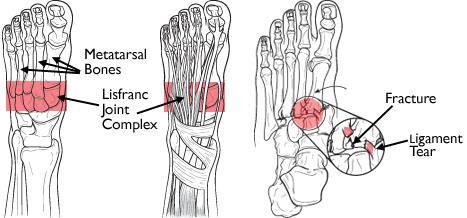What is it?
Lisfranc injuries are the result of broken bones, torn ligaments or dislocations of joints in your midfoot (metatarsals and tarsals).
All the bones in your midfoot are attached by ligaments that run vertical and horizontal to protect the bones from injury. However, there are no ligaments that attach the first metatarsal to the second metatarsal and therefor this joint is more prone to injury such as dislocation or fracture during a twisting fall compared to the others.
Lisfranc injuries can be simple that only affect one joint/bone or they can be very complex, involving multiple joints and bones. They are significant injuries that can take many months recover from.
How does it get injured?
Lisfranc injuries can happen with a simple low impact twist and fall with the foot pointed down. This is very common in football players. More severe injuries occur from trauma such as a fall from a height or a crush injury.
What does it feel like?
Pain can vary depending on severity but in the majority of cases pain is worse when standing, walking or attempting to stand or push off from the affected foot. You may not be able to put any weight through your foot and may require crutches.
How does it get diagnosed?
You will need an x-ray if you are unable to put any weight through your foot to assess for any broken bones or ligament disruption. Depending on the X-ray results surgery may be indicated if there are complex fractures or dislocations present. Lisfranc injuries can be missed quite easily if the x-rays are not in a non-weight bearing position. Weight through your foot results in more stress through your joints, ligaments and bones and therefore is more likely to show up an injury.
The following signs and symptoms also aid diagnosis: swelling on the top of the foot, bruising on the top and particularly the bottom of the foot, pain on touching the bones in the midfoot, pain when standing on the injured foot and seeing if you can stand on up on your tiptoes.
If the plan is for conservative management then you will be put in a removable boot. This allows your ligaments to heal over a period of 6 to 8 weeks. Your doctor may tell you not to weight bear for several weeks.
What can Back In Action do to help?
In the first few weeks post injury the initial treatment would be to manage pain, swelling and to maintain the movement in your ankle but restricting the movement in your foot to allow for adequate healing to occur. Advice regarding your walking and use of crutches will be provided. We can also refer for the appropriate orthotics if required.
Once your injury starts to heal and you are able to but more weight through your foot with less discomfort, exercises will be given to start to get the forefoot moving and a graded strengthening exercise programme will be prescribed for your foot and ankle. After having your foot in a boot for 6-8 weeks, your ankle joint and small joints in your foot and toes will be stiff so some manual techniques can help get them moving again.
When you are able to put full weight through your foot we will guide you on how to walk again with good technique and progress you on to some weight bearing exercises and appropriate cardiovascular training. We will the continue to strengthen your foot and ankle through some higher level exercises back to your activity or sport.

